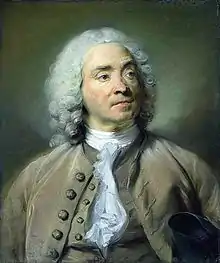Gabriel Huquier
Gabriel Huquier (1695–1772) was an entrepreneurial French draughtsman, engraver, printmaker, publisher, and art collector, who became a pivotal figure in the production of French 18th-century ornamental etchings and engravings[1]

Biography
Huquier moved to Paris from Orléans in 1727 and opened a workshop, Aux armes d'Angleterre at rue Saint-Denis in the vicinity of the Grand Châtelet, advertising in the Mercure de France. In 1734, he etched the first print after François Boucher, Andromeda, which was followed by many others. Altogether, Huquier published over eighty of Boucher's prints, including his chinoseries.[2]
Huquier became a prominent engraver and designer of ornament in an advanced Rococo taste, working from about 1731 until his apparent retirement in 1761. He engraved Watteau's designs, interpreting and adapting them so that he became the main source through whom Watteau's ornament was known in the 18th century[3] and went on to etch and engrave designs of Jacques de Lajoue, François Boucher, Gilles-Marie Oppenord,[4] Juste-Aurèle Meissonnier, Alexis Peyrotte, Nicolas Pineau and many other contemporary painters and designers.
Huquier was a collector of works of art,[5] whose collections were dispersed at three great auction sales, in Amsterdam, 1761, in Paris, 1771, and after his death, in Paris, 1772.[6]
Legacy
His son Jacques (or James) Gabriel Huquier (1730–1805) known as Huquier fils, was also an engraver, as well as a portrait painter.
Works by Huquier are held in the collections of the Cooper-Hewitt, National Design Museum,[7] the Science Museum Group,[8] the Fine Arts Museum of San Francisco,[9] the Minneapolis Institute of Art,[10] the University of Michigan Museum of Art,[11] the British Museum,[12] the Metropolitan Museum of Art,[13] and the Harvard Art Museums.[14]
References
- Susan Miller. "Jean-Antoine Fraisse, 'Gravé par Huquier'," Metropolitan Museum Journal, Vol. 31, (1996), pp. 127-130; Katie Scott. The Rococo Interior, 1995247-52.
- Hyde, Melissa, François Boucher, Melissa Lee Hyde, and Mark Ledbury. Rethinking Boucher. Los Angeles, CA: Getty Research Institute, 2006, pp. 100-107.
- Martin Eidelberg. "Gabriel Huquier- Friend or Foe of Watteau?", The Print Collector's Newsletter, 15, 1984, pp. 158-164.
- Jean-François Bédard, "Prints by Gabriel Huquier after Oppenord's Decorated Ripa," Print Quarterly, XXIX, no. 1, 2012, pp. 37-43.
- Yves Bruand. "Un grand collectionneur, marchand et graveur du XVIIIe siècle, Gabriel Huquier (1695-1772)", Gazette des Beaux-Arts, 1950, pp. 99-114.
- Simon Jervis, "Huquier's 'Second Livre'," The J. Paul Getty Museum Journal, 14, 1986, pp. 113-120.
- Gabriel Huquier, Cooper Hewitt, Smithsonian Design Museum
- "William Radcliffe | Science Museum Group Collection". collection.sciencemuseumgroup.org.uk. Retrieved 2021-02-16.
- "Le Théatre - Jacques Gabriel Huquier, Gabriel Huquier, Jean-Antoine Watteau". FAMSF Search the Collections. 2017-09-20. Retrieved 2021-02-16.
- "Costume Plate XXIV, Antoine Watteau; Printer: Jacques Gabriel Huquier ^ Minneapolis Institute of Art". collections.artsmia.org. Retrieved 2021-02-16.
- "Exchange: Capriccio with Roman Ruins, one of two "Monuments antiques"". exchange.umma.umich.edu. Retrieved 2021-02-16.
- "drawing | British Museum". The British Museum. Retrieved 2021-02-16.
- www.metmuseum.org https://www.metmuseum.org/art/collection/search/394318. Retrieved 2021-02-16.
{{cite web}}: Missing or empty|title=(help) - Harvard. "From the Harvard Art Museums' collections Parrot and a Bunch of Grapes, with Game Birds". harvardartmuseums.org. Retrieved 2021-02-16.
External links
 Media related to Gabriel Huquier at Wikimedia Commons
Media related to Gabriel Huquier at Wikimedia Commons